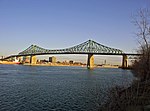Longueuil station
1967 establishments in QuebecBuildings and structures in LongueuilRailway stations in Canada at university and college campusesRailway stations in Canada opened in 1967Transport in Longueuil ... and 1 more
Yellow Line (Montreal Metro)

Longueuil station, officially Longueuil–Université-de-Sherbrooke station, is a Montreal Metro station in Longueuil, Quebec, Canada. It is operated by the Société de transport de Montréal (STM) and is the southern terminus of the Yellow Line. It is connected to a campus of Université de Sherbrooke, as well as the largest bus station in Greater Montreal, Terminus Longueuil. It is one of the busiest stations on the Metro network, with 40% of public transit users from the South Shore using the Yellow Line in the morning peak.
Excerpt from the Wikipedia article Longueuil station (License: CC BY-SA 3.0, Authors, Images).Longueuil station
Place Charles-Le Moyne, Longueuil
Geographical coordinates (GPS) Address Nearby Places Show on map
Geographical coordinates (GPS)
| Latitude | Longitude |
|---|---|
| N 45.525277777778 ° | E -73.521944444444 ° |
Address
Place Charles-Le Moyne
Place Charles-Le Moyne
J4K 4Y9 Longueuil
Quebec, Canada
Open on Google Maps








